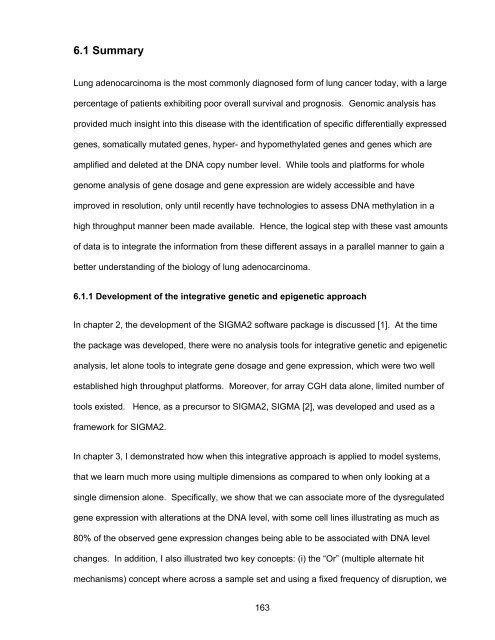Chapter 2 - University of British Columbia
Chapter 2 - University of British Columbia
Chapter 2 - University of British Columbia
Create successful ePaper yourself
Turn your PDF publications into a flip-book with our unique Google optimized e-Paper software.
6.1 Summary<br />
Lung adenocarcinoma is the most commonly diagnosed form <strong>of</strong> lung cancer today, with a large<br />
percentage <strong>of</strong> patients exhibiting poor overall survival and prognosis. Genomic analysis has<br />
provided much insight into this disease with the identification <strong>of</strong> specific differentially expressed<br />
genes, somatically mutated genes, hyper- and hypomethylated genes and genes which are<br />
amplified and deleted at the DNA copy number level. While tools and platforms for whole<br />
genome analysis <strong>of</strong> gene dosage and gene expression are widely accessible and have<br />
improved in resolution, only until recently have technologies to assess DNA methylation in a<br />
high throughput manner been made available. Hence, the logical step with these vast amounts<br />
<strong>of</strong> data is to integrate the information from these different assays in a parallel manner to gain a<br />
better understanding <strong>of</strong> the biology <strong>of</strong> lung adenocarcinoma.<br />
6.1.1 Development <strong>of</strong> the integrative genetic and epigenetic approach<br />
In chapter 2, the development <strong>of</strong> the SIGMA2 s<strong>of</strong>tware package is discussed [1]. At the time<br />
the package was developed, there were no analysis tools for integrative genetic and epigenetic<br />
analysis, let alone tools to integrate gene dosage and gene expression, which were two well<br />
established high throughput platforms. Moreover, for array CGH data alone, limited number <strong>of</strong><br />
tools existed. Hence, as a precursor to SIGMA2, SIGMA [2], was developed and used as a<br />
framework for SIGMA2.<br />
In chapter 3, I demonstrated how when this integrative approach is applied to model systems,<br />
that we learn much more using multiple dimensions as compared to when only looking at a<br />
single dimension alone. Specifically, we show that we can associate more <strong>of</strong> the dysregulated<br />
gene expression with alterations at the DNA level, with some cell lines illustrating as much as<br />
80% <strong>of</strong> the observed gene expression changes being able to be associated with DNA level<br />
changes. In addition, I also illustrated two key concepts: (i) the “Or” (multiple alternate hit<br />
mechanisms) concept where across a sample set and using a fixed frequency <strong>of</strong> disruption, we<br />
163

















